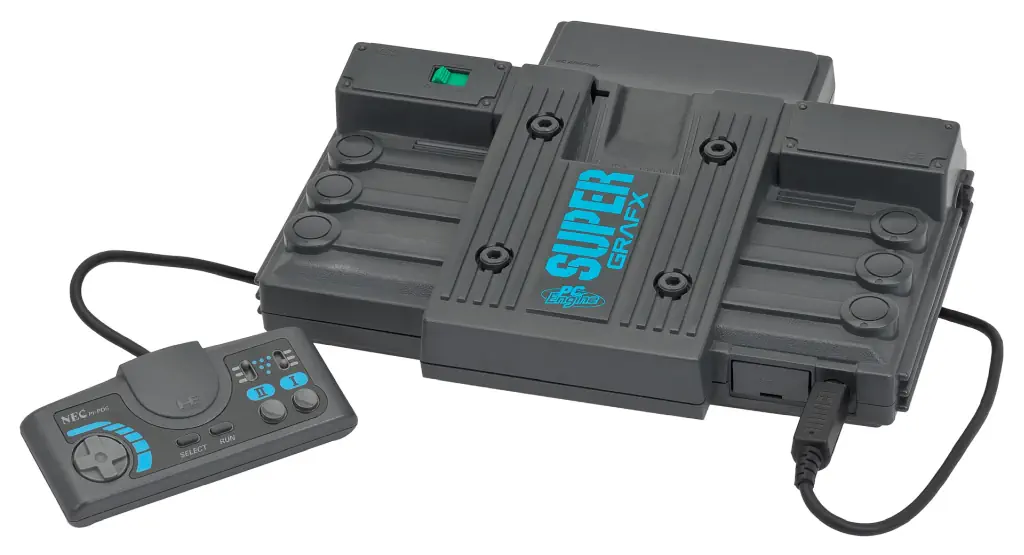PC Engine SuperGrafx
The PC Engine SuperGrafx was released in 1989 by NEC Home Electronics as the successor to the PC Engine and the American TurboGrafx-16 consoles. It was marketed as a true 16-bit machine with improved graphics and audio capabilities over its predecessor. The SuperGrafx was a commercial disaster, only 75,000 total units sold and only six games were released that took advantage of the advanced hardware.
Compared to the PC Engine, the SuperGrafx had four times the working RAM, but it was still only 32kByte. The main upgrade of this console was the additional video chip with its own VRAM, and a priority chip that allowed both video chips to be combined in various different ways. This gave the SuperGrafx twice as many on-screen sprites, and the ability for two independently scrolling background layers.
The SuperGrafx was backwards compatible with the standard PC Engine HuCards, as well as the its own new SuperGrafx-specific HuCards. These were expensive, running around $110 each. The SuperGrafx is also compatible with the CD-ROM2 system add-on via a ROM2 adaptor. But no new CD-ROM games were developed that took advantage of the SuperGrafx's upgraded capabilities.
New CPU
The CPU was the 8-bit HuC6280A running at 7.16MHz or 1.79MHz (software switchable). This CPU is a modified 65SC02 cpu (6502 compatible). It features integrated bankswitching hardware addressing a 21-bit bus from the 16-bit wide CPU address bus. The CPU also had an integrated general purpose I/O port, block transfer instructions, a timer, and dedicated data move instrunctions for communicating with the HuC6207 VDC.New Display Subsystem
The display subsystem was composed of two 16-bit HuC6270A Video Display Controllers (VDCs), one HuC6202 Video Priority Controller, and one HuC6260 Video Color Encoder (VCE). The HuC6270A featured Port-based I/O similar to the TMS99xx VDP family.The X (Horizontal) Resolution was variable, maximum of 565 pixels (programmable to 282, 377 or 565 pixels, or as 5.37mhz, 7.159mhz, and 10.76mhz pixel dot clock). Due to TV restrictions, most game developers limited their games to either 256, 336, or 512 pixels in display width for each of the three modes. The Y (Vertical) Resolution was also variable with a maximum of 242 (programmable in increments of 1 scanline).
Color had a depth of 9 bits with 512 colors available with up to 512 colors on screen (241 background and 240 sprite colors from each of the two VDCs). There were 32 palettes in total: 16 for background tiles and 16 for sprites. Each sprite palette could have 15 colors defined, and had one transparent color index; and each background tile palette could have 15 colors defined, and had one color index with a color that was shared across all background tile palettes.
128 sprites were simultaneously displayable with sizes of: 16×16, 16×32, 16×64, 32×16, 32×32, 32×64. Each sprite can use up to 15 unique colors and one reserved as transparent. Colors came from one of the 16 available sprite palettes. The dual HuC6270A VDCs are capable of displaying 2 sprite layers (1 each). Sprites could be placed either in front of or behind background tiles. Each layer can display 16 sprites or 256 sprite pixels per scanline, giving the combined sprite per scanline limit of 32 sprites or 512 sprite pixels.
Tiles were 8x8 with each background tile able to use up to 16 unique colors via one of the 16 available background palettes. The first color entry of each background palette must be the same across all background palettes.
Sound Capabilities
There were six wavetable synthesis audio channels available that were controlled by the CPU. Each channel had a bit depth of 5 bits, and was allotted 20 bytes of RAM for sample data. The waveforms were programmable, so composers could up with patterns for unique waveforms. The system supported software enabled direct D/A which allows for sampled sound to be directly streamed into any of the six PSG audio channels. The frequency would be limited to around 7kHz. A combination of two or more channels resulted in play back capability of 8, 9 or 10-bit samples. The CD-ROM drive added CD-DA sound capabilities, and a single ADPCM channel.SuperGrafx Controller

VRAM: 128 kB Sound Chip HU6280A, PSG Sound 6 PSG channels
5-bit depth samples 7kHz Display Chip 2x HuC6270A VDC
HuC6202 VPC
HuC6260 VCE Display 256x239 in 482 out of 512 colors
565x242 in 482 out of 512 colors Best Color 512 colors Best Graphics 565x242 Sprites 128 Sprites Storage HuCard ROM cartridges


